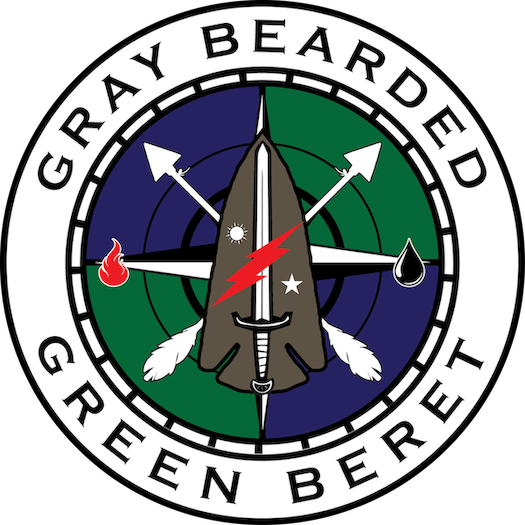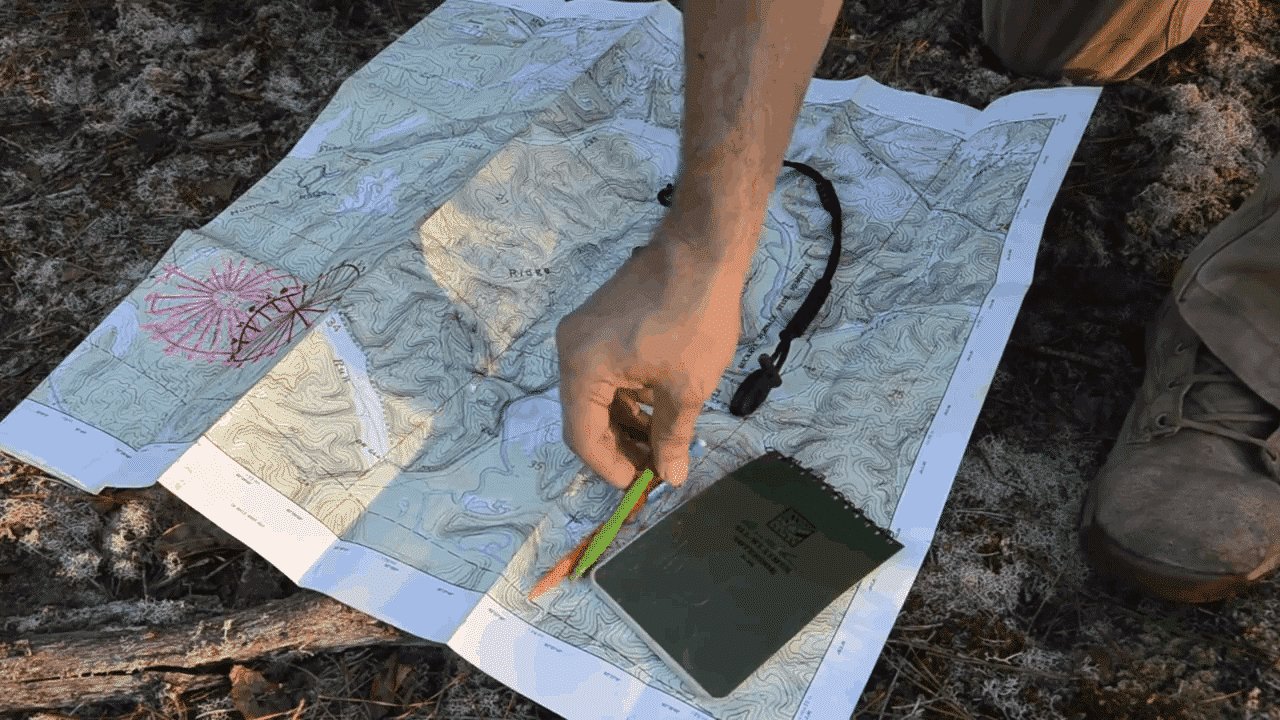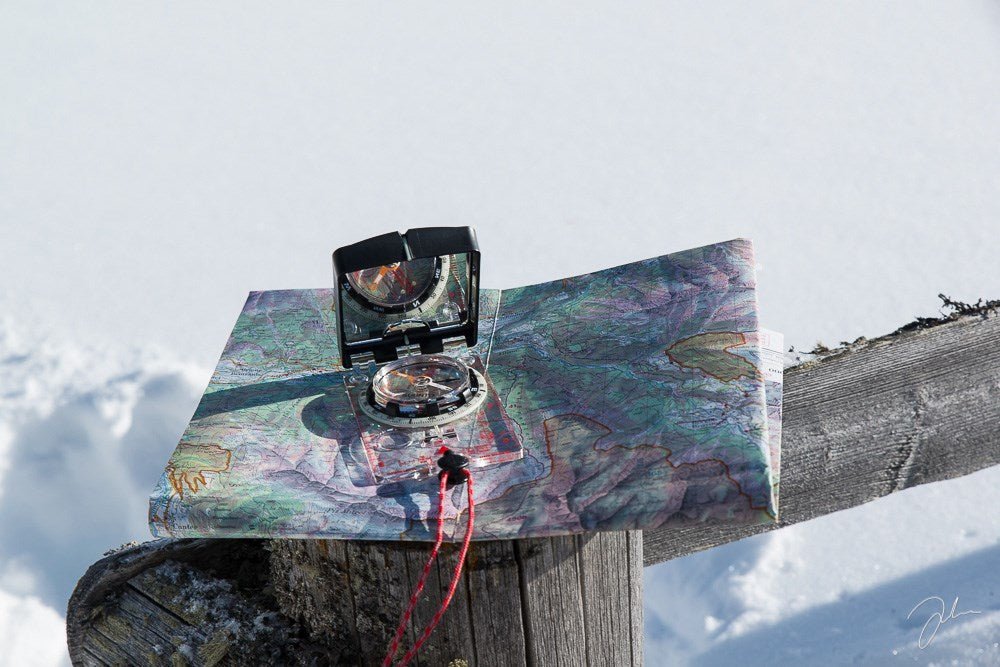Navigation and Signal Kits
The baseline for the navigation kit is a reliable compass. There are a number of different types, styles, and brands to choose from. The important thing is knowing how to use whichever brand you choose, and to be well-practiced with it. The compass should have adjustable declination; if it doesn’t, the burden of converting is on you.

When possible, you should choose items that serve more than one function. The Suunto MC2 compass is a great choice because it also has a mirror that can be used for signaling as well as other applications.
Compasses are most useful for showing the direction of travel, reducing lateral drift by allowing the user to walk a straighter line, and measuring angles between points.
Generally speaking, if all you need to do is walk a certain direction to make our way back to civilization, that can be done with nothing more than a compass. You still have to know what that direction is beforehand. If you are lost, there is less of a chance of you actually knowing what direction that needs to be.
Compasses work best when paired with a good map of the area, and of course the knowledge and skill to use both of them. Being able to plot coordinates, routes, and take notes while you are navigating is a huge convenience.
You should carry a waterproof notebook that doesn’t get ruined if it gets wet from rain or sweat, and a mechanical pencil to make marks and write with. Mechanical pencils are preferred over one that you have to sharpen as it gets dull because it allows you to make a much more precise mark on the map. Those marks are used to then measure angles and distances between points so precision is critical.
A compass gives you the ability to measure and walk certain angles, so that is a tool for angular measurement. The map is used to determine what that angle needs to be to get to where you want to go, and you use the bar scales (among other things) on the map to calculate the distance.
Your “pace count” is what you use for measuring horizontal distance actually travelled “on the ground”. The farther you go, the more difficult it is to keep track of and the easier it is for me to lose my count. The easiest way to track this is with a good set of pace beads. These are sometimes referred to as “Ranger Beads”, even though they are used and considered essential pieces of gear for a number of different units.
 Last, but not least, you may or may not need a protractor, sometimes referred to as a “coordinate scale”. The scale you need depends on the scale of your map. Protractors are a tool for measuring angles, distances, and coordinates on a map during route planning. Many compasses have scales on them already that can be used to measure distances and plot coordinates, and the compass itself measures angles. If your compass has these, and you know how to use it, you may not need a protractor. If it doesn’t, you will need to add one of these to your kit and learn how to use it.
Last, but not least, you may or may not need a protractor, sometimes referred to as a “coordinate scale”. The scale you need depends on the scale of your map. Protractors are a tool for measuring angles, distances, and coordinates on a map during route planning. Many compasses have scales on them already that can be used to measure distances and plot coordinates, and the compass itself measures angles. If your compass has these, and you know how to use it, you may not need a protractor. If it doesn’t, you will need to add one of these to your kit and learn how to use it.
THE ABILITY TO READ MAPS AND NAVIGATE WITHOUT GETTING LOST OPENS UP THE ENTIRE WILDERNESS TO YOU.

This is likely why the GB2 Master Navigator Course continues to be the most popular course offering and is known as one of the best courses for navigation available in the industry.
Survival Navigation Kit:
- Compass
- Map
- Waterproof Notebook
- Mechanical Pencil(s)
- Pace Beads
- Protractor
Survival Signals
A good signal kit will give you a variety of options for making yourself more visible under a variety of conditions. It is important to note that there is a difference between passive signals, which are working for you while you focus on other tasks, and active signals that require you to actively be using them to draw attention.
 With that in mind, you want passive and active signal options for the day, as well as both types meant for night. You also want signals that are audible. Those are universal in the sense that they are useful day or night.
With that in mind, you want passive and active signal options for the day, as well as both types meant for night. You also want signals that are audible. Those are universal in the sense that they are useful day or night.
Types of Signals:
- Passive
- Day
- Night
- Active
- Day
- Night
- Audible
PASSIVE SIGNALS
The best passive daytime signal is going to be a signal panel. This can be a dedicated panel, but it can also be integrated into another kit item. The GB2 Haversack has a back panel that is bright orange and is meant for this purpose specifically. The GB2 Multipurpose Mat also has an integrated signal panel.
When possible, you should always choose brightly-colored items that contrast well with the environment you are in. International Orange is the color most associated with this. Some studies have shown a Royal Blue to be even more visible and may one day be the new standard. This is a great way to supplement your passive daytime signal kit.
Passive night time signals could include anything from using reflective cordage to reflective trail markers. Reflective tape on your backpack is another good one. You may choose to pack a brightly colored vests that have reflective strips on it, similar to what road workers or joggers would wear, and those work well as passive day and night signals.
At a minimum, the passive light from your fire or headlamp while you do other tasks can be an effective passive signal that can be seen well at night.
IN AN EMERGENCY KIT, ANY GEAR THAT CAN BE BRIGHTLY COLORED, SHOULD BE BRIGHTLY COLORED.
ACTIVE SIGNALS
Active signals are only used when you are actively trying to get someones attention and have reason to believe there is someone on the other end that will see it. Actively signaling when you have no reason to expect anyone is watching or could see it is a waste of time and calories. Doing it at night, especially when using items that require batteries, is a waste of the resource.
Many of your passive daytime signals can be used in an active fashion. If you are waving your signal panel around to create more visible movement to get someones attention, you are actively signaling.
The best active daytime signal is a signal mirror. This can be a dedicated signal mirror, or the mirror that’s on your compass if you have that available. These can be used to reflect the sun in the direction of a potential source of help and the light from these can be seen at a great distance.
Active night time signals are often more limited as they typically need batteries or some form of energy. An exception to that is chemical light sticks that you break and they glow fairy brightly as a result. The light from your headlamp can be seen at a considerable distance depending on the terrain and vegetation.
Just keep in mind you may need the headlamp to perform other necessary tasks after the sun goes down and battery life may be a concern. Light sticks can be used, but remember that once they are broken and used, that is it.
While everything else we’ve discussed are sight-based signals, the “universal” signal is an auditory one. That signal is the whistle. It doesn’t matter night or day, it can be heard if you are actively blowing it.
 It should be mentioned that fire is a highly effective signal. Between the smoke and the light, as well as the smell (olfactory), it may be one of the most effective signals at your disposal; and you are going to need it for a number of other priorities as well.
It should be mentioned that fire is a highly effective signal. Between the smoke and the light, as well as the smell (olfactory), it may be one of the most effective signals at your disposal; and you are going to need it for a number of other priorities as well.
One of the most comprehensive signal kits available is the GB2 Signaling BOSS Kit. It includes a variety of active and passive, day and night signals as well as a whistle. That along with the passive signals built into your other kit items makes for an incredibly complete kit.
Recommended Signal Kit:
- GB2 Haversack
- GB2 Multipurpose Mat
- Reflective Cordage
- GB2 Signaling BOSS Kit
- Headlamp
- Extra Batteries
- Whistle (if no BOSS Kit)
Join us for a Live Course or Workshop here. For more details on this and similar topics, please see my downloadable videos here or downloadable PDFs here.
Be Prepared First. I hope to see you around our campfire soon!
-Joshua




